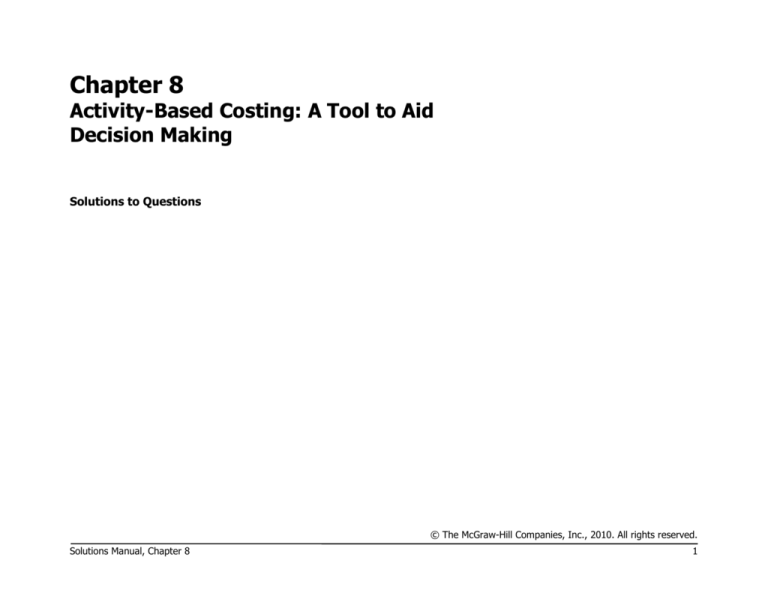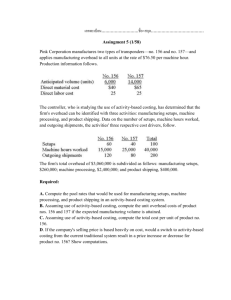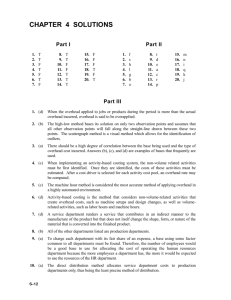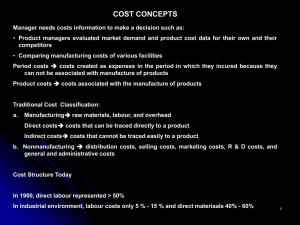
Chapter 8
Activity-Based Costing: A Tool to Aid
Decision Making
Solutions to Questions
© The McGraw-Hill Companies, Inc., 2010. All rights reserved.
Solutions Manual, Chapter 8
1
Exercise 8-3 (10 minutes)
Activity Cost Pool
Caring for lawn .....................
Caring for garden beds–
low maintenance ................
Caring for garden beds–high
maintenance ......................
Travel to jobs .......................
Customer billing and service ..
Estimated
Overhead
Cost
Expected Activity
$72,000
$26,400
150,000
20,000
$41,400
15,000
$3,250
$8,750
12,500
25
square feet of
lawn
square feet of low
maintenance beds
square feet of high
maintenance beds
miles
customers
Activity Rate
$0.48 per square foot of
lawn
$1.32 per square foot of low
maintenance beds
$2.76 per square foot of high
maintenance beds
$0.26 per mile
$350 per customer
The activity rate for each activity cost pool is computed by dividing its estimated overhead cost by its
expected activity.
© The McGraw-Hill Companies, Inc., 2010. All rights reserved.
2
Managerial Accounting, 13th Edition
Exercise 8-4 (10 minutes)
K425
Activity Cost Pool
Supporting direct labor .........
Machine processing ..............
Machine setups ....................
Production orders .................
Shipments ............................
Product sustaining ................
Total ....................................
M67
Activity Cost Pool
Supporting direct labor .........
Machine processing ..............
Machine setups ....................
Production orders .................
Shipments ............................
Product sustaining ................
Total ....................................
$6
$4
$50
$90
$14
$840
$6
$4
$50
$90
$14
$840
Activity Rate
per
per
per
per
per
per
direct labor-hour
machine-hour
setup
order
shipment
product
Activity Rate
per
per
per
per
per
per
80
100
1
1
1
1
direct labor-hour
500
machine-hour
1,500
setup
4
order
4
shipment
10
product
1
Activity
ABC Cost
Activity
ABC Cost
direct labor-hours
machine-hours
setups
order
shipment
product
direct labor-hours
machine-hours
setups
orders
shipments
product
$ 480
400
50
90
14
840
$1,874
$ 3,000
6,000
200
360
140
840
$10,540
© The McGraw-Hill Companies, Inc., 2010. All rights reserved.
Solutions Manual, Chapter 8
3
Exercise 8-7 (30 minutes)
1. Activity rates are computed as follows:
Activity Cost Pool
Machine setups ......
Special processing ..
General factory ......
(a)
Estimated
Overhead
Cost
(b)
Expected
Activity
$72,000
400 setups
$200,000 5,000 MHs
$816,000 24,000 DLHs
(a) ÷ (b)
Activity
Rate
$180 per setup
$40 per MH
$34 per DLH
2. Overhead is assigned to the two products as follows:
Hubs:
Activity Cost Pool
Machine setups .....................
Special processing .................
General factory .....................
Total.....................................
(a)
Activity Rate
$180 per setup
$40 per MH
$34 per DLH
(b)
Activity
100 setups
5,000 MHs
8,000 DLHs
(a) × (b)
ABC Cost
(a)
Activity Rate
(b)
Activity
(a) × (b)
ABC Cost
$ 18,000
200,000
272,000
$490,000
Sprockets:
Activity Cost Pool
Machine setups .....................
Special processing .................
General factory .....................
Total.....................................
$180 per setup
300 setups
$40 per MH
0 MHs
$34 per DLH 16,000 DLHs
$ 54,000
0
544,000
$598,000
© The McGraw-Hill Companies, Inc., 2010. All rights reserved.
4
Managerial Accounting, 13th Edition
Exercise 8-7 (continued)
Direct materials ...................................
Direct labor:
$15 per DLH × 0.80 DLHs per unit.....
$15 per DLH × 0.40 DLHs per unit.....
Overhead:
$490,000 ÷ 10,000 units ...................
$598,000 ÷ 40,000 units ...................
Unit cost .............................................
Hubs
$32.00
12.00
49.00
$93.00
Sprockets
$18.00
6.00
14.95
$38.95
© The McGraw-Hill Companies, Inc., 2010. All rights reserved.
Solutions Manual, Chapter 8
5
Exercise 8-14 (30 minutes)
1. First-stage allocations of overhead costs to the activity cost pools:
Wages and salaries..........
Other overhead costs ......
Wages and salaries..........
Other overhead costs ......
Total cost........................
Distribution of Resource Consumption
Across Activity Cost Pools
Supporting Order Pro- Customer
Direct Labor
cessing
Support
Other
Totals
Direct Labor Order ProSupport
cessing
Totals
40%
30%
$120,000
30,000
$150,000
30%
10%
$ 90,000
10,000
$100,000
20%
20%
Customer
Support
$ 60,000
20,000
$ 80,000
10%
40%
Other
$ 30,000
40,000
$ 70,000
Example: 40% of $300,000 is $120,000.
2. Computation of activity rates:
Activity Cost Pools
Supporting direct
labor .....................
Order processing ......
Customer support .....
(a)
Total Cost
(b)
Total Activity
$150,000 20,000 DLHs
$100,000
400 orders
$80,000
200 customers
(a) ÷ (b)
Activity Rate
$7.50 per DLH
$250 per order
$400 per customer
© The McGraw-Hill Companies, Inc., 2010. All rights reserved.
6
Managerial Accounting, 13th Edition
100%
100%
$300,000
100,000
$400,000
Exercise 8-14 (continued)
3. Computation of the overhead costs for the Shenzhen Enterprises order:
Activity Cost Pool
Supporting direct
labor .................
Order processing ..
Customer support
Total....................
(a)
Activity Rate
$7.50 per DLH
$250 per order
$400 per customer
(b)
Activity
(a) × (b)
ABC Cost
20 DLHs*
$150
1 order
250
1 customer 400
$800
*2 DLHs per unit × 10 units = 20 DLHs.
4. The customer margin for Shenzhen Enterprises is computed as follows:
Customer Margin—ABC Analysis
Sales (10 units × $300 per unit).....................
Costs:
Direct materials ($180 per unit × 10 units) ...
Direct labor ($50 per unit × 10 units) ...........
Support direct labor overhead (see part 3
above) .....................................................
Order processing overhead (see part 3
above) .....................................................
Customer support overhead (see part 3
above) .....................................................
Customer margin ...........................................
$3,000
$1,800
500
150
250
400
3,100
$ (100)
© The McGraw-Hill Companies, Inc., 2010. All rights reserved.
Solutions Manual, Chapter 8
7
Problem 8-16 (45 minutes)
1. Under the traditional direct labor-hour based costing system, manufacturing overhead is applied to products using the predetermined overhead rate computed as follows:
Predetermined = Estimated total manufacturing overhead cost
overhead rate
Estimated total direct labor -hours
=
$1,980,000
= $16.50 per DLH
120,000 DLHs *
*20,000 units of Xtreme @ 2.00 DLH per unit + 80,000 units of the
Pathfinder@ 1.0 DLH per unit = 40,000 DLHs + 80,000 DLHs = 120,000
DLHs.
Consequently, the product margins using the traditional approach would
be computed as follows:
Sales ...................................
Direct materials ....................
Direct labor ..........................
Manufacturing overhead
applied @ $16.50 per
direct labor-hour ................
Total manufacturing cost ......
Product margin ....................
Xtreme
Pathfinder
Total
$2,800,000
1,440,000
480,000
$7,920,000
4,240,000
960,000
$10,720,000
5,680,000
1,440,000
660,000
2,580,000
$ 220,000
1,320,000
6,520,000
$1,400,000
1,980,000
9,100,000
$ 1,620,000
Note that all of the manufacturing overhead cost is applied to the products under the company’s traditional costing system.
© The McGraw-Hill Companies, Inc., 2010. All rights reserved.
8
Managerial Accounting, 13th Edition
Problem 8-16 (continued)
2. The first step is to determine the activity rates:
Activity Cost Pools
(a)
Total
Cost
(b)
Total Activity
Supporting direct
labor ................... $783,600 120,000 DLH
Batch setups .......... $495,000
300 setups
Product sustaining .. $602,400
2 products
(a) ÷ (b)
Activity Rate
$6.53 per DLH
$1,650 per setup
$301,200 per product
*The Other activity cost pool is not shown above because it includes organization-sustaining and idle capacity costs that should not be assigned
to products.
Under the activity-based costing system, the product margins would be
computed as follows:
Sales ................................
Direct materials .................
Direct labor .......................
Supporting direct labor ......
Batch setups .....................
Product sustaining .............
Total cost .........................
Product margin .................
Xtreme
$2,800,000
1,440,000
480,000
261,200
330,000
301,200
2,812,400
$ (12,400)
Pathfinder
$7,920,000
4,240,000
960,000
522,400
165,000
301,200
6,188,600
$1,731,400
Total
$10,720,000
5,680,000
1,440,000
783,600
495,000
602,400
9,001,000
$ 1,719,000
© The McGraw-Hill Companies, Inc., 2010. All rights reserved.
Solutions Manual, Chapter 8
Problem 8-16 (continued)
3. The quantitative comparison is as follows:
Traditional Cost System
Direct materials .......................
Direct labor .............................
Manufacturing overhead ..........
Total cost assigned to products
Xtreme
Pathfinder
Total
(a)
(a) ÷ (c)
(b)
(b) ÷ (c)
(c)
Amount
%
Amount
%
Amount
$1,440,000
25.4% $4,240,000
74.6% $5,680,000
480,000
33.3%
960,000
66.7% 1,440,000
660,000
33.3% 1,320,000
66.7% 1,980,000
$2,580,000
$6,520,000
$9,100,000
Activity-Based Costing System
Direct costs:
Direct materials .......................
Direct labor .............................
Indirect costs:
Supporting direct labor ............
Batch setups ...........................
Product sustaining ...................
Total cost assigned to products
Costs not assigned to products:
Other ......................................
Total cost ................................
$1,440,000
480,000
25.4% $4,240,000
33.3%
960,000
74.6% $5,680,000
66.7% 1,440,000
261,200
330,000
301,200
$2,812,400
33.3%
66.7%
50.0%
66.7%
33.3%
50.0%
522,400
165,000
301,200
$6,188,600
99,000
$9,100,000
© The McGraw-Hill Companies, Inc., 2010. All rights reserved.
10
783,600
495,000
602,400
9,001,000
Managerial Accounting, 13th Edition
Problem 8-16 (continued)
The traditional and activity-based cost assignments differ for two reasons. First, the traditional system assigns all $1,980,000 of manufacturing overhead to products. The ABC system assigns only $1,881,000 of
manufacturing overhead to products. The ABC system does not assign
the $99,000 of Other activity costs to products because they represent
organization-sustaining and idle capacity costs. Second, the traditional
system uses one unit-level activity measure, direct labor hours, to assign
33.3% of all overhead to the Xtreme product line and 66.7% of all
overhead to the Pathfinder product line. The ABC system assigns 66.7%
of Batch setup costs (a batch-level activity) to the Xtreme product line
and 33.3% to the Pathfinder product line. The ABC system assigns 50%
of Product sustaining costs (a product-level activity) to each product
line.
© The McGraw-Hill Companies, Inc., 2010. All rights reserved.
Solutions Manual, Chapter 8
11
© The McGraw-Hill Companies, Inc., 2010. All rights reserved.
12
Managerial Accounting, 13th Edition







